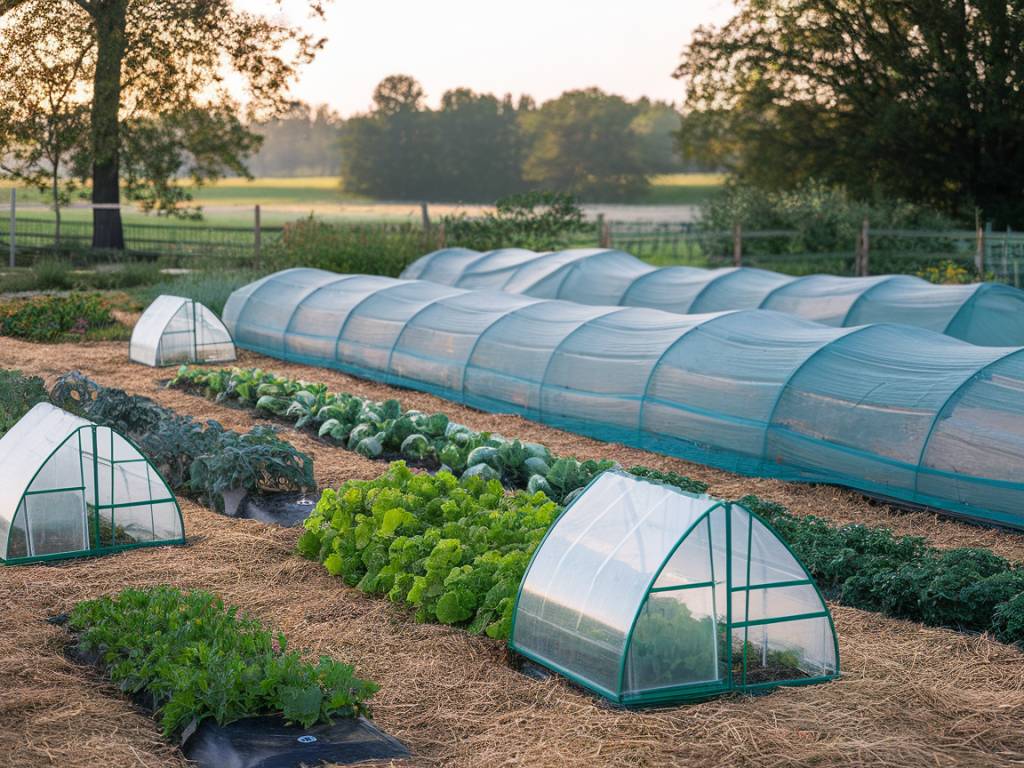As winter approaches, many gardeners start to worry about how to protect their plants from the harsh conditions ahead. Using garden cloches and row covers can be a game-changer in ensuring your plants stay healthy and thriving through the colder months. I love using these tools in my garden, and I’m excited to share my tips and experiences with you. Here’s how you can make the most out of garden cloches and row covers during winter!
Understanding Garden Cloches
Garden cloches are essentially small, portable greenhouses for individual plants or small groups. They can be made from glass, plastic, or even DIY materials such as old plastic bottles. The primary goal of a cloche is to trap heat and moisture, providing a more stable microenvironment for your plants.
Best Practices for Using Garden Cloches
When placing cloches over your plants, make sure that the soil is well-watered. The trapped moisture will help create a humid environment beneficial for plant growth. Also, it’s crucial to ensure proper ventilation. On sunny winter days, cloches can get quite warm, and lack of ventilation can stress the plants.
To optimize the use of cloches:
- Place cloches over seedlings and young plants to give them a head start.
- Use cloches on frost-sensitive plants to extend their growing season.
- Remove cloches during the day to prevent overheating on warmer winter days.
- Ensure the cloches are securely anchored to prevent wind from blowing them away.
Exploring Row Covers
Row covers are fabric sheets designed to be draped over rows of plants. They can be made from various materials, including lightweight fabrics that allow water and sunlight to penetrate while still offering protection from frost, wind, and pests. Row covers can span entire garden beds, making it easy to protect larger areas.
How to Use Row Covers Effectively
When installing row covers, it’s essential to support the fabric with hoops or a framework. This helps keep the cover off the plants, reducing the risk of damage and allowing for better air circulation. Secure the edges of the row covers with soil, rocks, or stakes to prevent them from blowing away.
Key tips for using row covers include:
- Choose the right fabric thickness. Thicker fabrics offer more frost protection but may reduce light penetration.
- Check the fabric regularly for tears or holes and repair them promptly.
- Remove the row covers on sunny days to prevent overheating, especially for cool-weather crops.
- Use row covers in combination with mulch to provide extra insulation.
Combining Cloches and Row Covers
I’ve found that combining cloches and row covers can provide excellent protection for a variety of plants. For instance, you can use cloches for individual plants and row covers for larger areas, ensuring that all your garden beds are adequately protected. This combination can be particularly effective in areas with unpredictable weather, where conditions can change rapidly.
Choosing the Right Materials
The materials you choose for your cloches and row covers can make a significant difference in their effectiveness. For cloches, glass is a traditional choice, but it’s heavier and more breakable than plastic. Plastic cloches are lighter and easier to handle but might not last as long. For row covers, you can choose between lightweight and heavyweight fabrics, depending on your plants’ needs.
Consider the following when choosing materials:
- Glass cloches: Durable but heavy and fragile.
- Plastic cloches: Lightweight and versatile but may have a shorter lifespan.
- Lightweight row covers: Allow more light and moisture through, ideal for cool-weather crops.
- Heavyweight row covers: Provide more frost protection, but reduce light penetration, suitable for more sensitive plants.
DIY Options
If you’re on a budget or love a good DIY project, you can make your garden cloches and row covers from recycled materials. Old plastic bottles, glass jars, and even clear storage bins can be repurposed into cloches. For row covers, old sheets or lightweight curtains can be utilized, provided they are breathable and allow some light through.
DIY tips include:
- Cut the bottoms off plastic bottles and place them over seedlings.
- Repurpose clear storage bins by placing them upside down over plants.
- Use old bed sheets as row covers, securing them with rocks or stakes.
Monitoring Your Plants
Even with the protection offered by cloches and row covers, it’s crucial to regularly monitor your plants. Check for signs of pests, disease, or stress, and take action promptly. Additionally, make sure the covers are still intact and properly positioned, especially after storms or strong winds.
Monitoring tips include:
- Inspect plants every few days for any signs of issues.
- Ensure proper ventilation to prevent mold and mildew.
- Adjust the covers as needed based on weather conditions.
Seasonal Adjustments
As winter progresses, the needs of your plants may change. Be prepared to adjust your cloches and row covers accordingly. For example, as days get longer and warmer, you might need to remove or ventilate the covers more frequently. Similarly, if an unexpected cold snap hits, you might need to add additional layers of protection.
Seasonal adjustment tips include:
- Monitor weather forecasts and adjust covers as needed.
- Add extra layers during cold spells for added protection.
- Remove or ventilate covers on warmer days to prevent overheating.
Using garden cloches and row covers during winter can make a significant difference in the health and productivity of your garden. These tools not only protect your plants from harsh weather conditions but also create a favorable growing environment. With these tips, you’ll be well-equipped to keep your garden thriving all winter long.
Happy gardening!
Samanta
